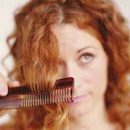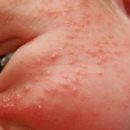Seborrhea - inflammatory skin disease associated with increasing the number and change in the quality of sebum.
Content
Seborrhea is manifested by the thickening of the horn layer, fatty and peeling of the skin. Segallays are affected by the areas of the scalp and body areas, on which the coolest glands are most developed, the forehead, the nasolabial triangle, the region of the oars, the front area of the chest and the inter-pump region. With the damage to the skin of the scalp, the thinning and breaking of the hair is observed.
Causes of Seborildy
As possible causes contributing to the occurrence of seborrhea, we consider genetic, exchange and influence of the external environment.
Currently, the leading role of the causative agent of Pitirosporum (yeast-like mushrooms) in the development of seborrheic dermatitis of the scalp and dandruff is confirmed by numerous clinical and laboratory studies. These yeast-like mushrooms are a permanent resident of healthy skin in more than 90% of the population. Mushrooms are concentrated around the sebaceous glands and use their secret to grow and development.
Under adverse conditions, a protective function of the skin and sebaceous glands occurs. In particular, the body loses the ability to control the growth of pithyrotry mushrooms, and their number increases significantly. The microflora of the scalp in the norm contains 30–50% of pithyrotorums, with dandruff, it consists of 75%.
 Among the factors contributing to the activation of fungi, the leading place belongs to the change in the composition of the skin, which significantly disrupts the protective function of the skin. Among the reasons that cause these changes, most dermatologists note neurogenic, hormonal, immune.
Among the factors contributing to the activation of fungi, the leading place belongs to the change in the composition of the skin, which significantly disrupts the protective function of the skin. Among the reasons that cause these changes, most dermatologists note neurogenic, hormonal, immune.
It is well known that Seborrhea is significantly aggravated with nervous stress. Patients with various diseases of the nervous system are largely susceptible to the incidence of seborrhea, in various forms of its manifestation. Patients with paraly grounds of the cranial nerves, paralycles of the body, Parkinson's disease and T.NS. have a high predisposition to the incidence of seborrhea.
As evidence of immunodeficiency in Seboro, data on the incidence of seborrhea among patients with severe immunodeficiency states is given: if healthy people seborrhea meet in 8% of cases, then HIV–It is observed in 36% infected, and in AIDS patients – In 80% of cases.
Hormonal imbalance also underlies the development of seborrhea. Sexation of sebum and hair growth are located under the direct control of male genital hormones. This is due to the fact that receptors for sex hormones are located on the surface of the skin cells. Against the background of the genetic predisposition of changes in the hormonal and immune status, changes in the secretion of the skin and disruption of the protective properties of the skin, which leads to the distribution and increase in the number of fungi and the development of foci of inflammation with impaired immune skin response, salo waste.
Manifestations Seboriy
Characteristic manifestations of seborrhea - peeling and inflammation of the skin, accompanied by itching. A classic variant of seborrhea is a symmetrical involvement in the process of skin of the scalp, the borders of the growth of hair, eyebrows, eyelashes of the beard area and mustache. Small white scales appear on the skin of the head. This variant of seborride flow is characterized by the absence of changes on the skin and is considered as dry seborrhea. Many patients in the presence of dandruff (weak form seborrhea) prealt complaints. If patients rarely wash their heads, the process progresses, captures new areas of skin cover, and peeling becomes more abundant. Inflammatory changes in this course of flow can be expressed slightly. The heavier flow of seborrhea is characterized by red spots and plaques on the skin, covered with scales, and in some cases, scales–crusts and bloody crusts. The process can involve the skin of the forehead, the earliest areas, the areas of the ears, the patients may complain about the sense of constant discomfort on the affected areas of the skin or pronounced itch. If the treatment is not carried out, the plaques may appear on the smooth skin of the face, back, chest and in some cases complicated by bacterial infection.
Seboridium treatment
To the treatment of seborrhea should be approached differential, depending on manifestations.
Modern methods of treating seborrhea are based on data confirming its fungal origin. It is the specific antifungal treatment of seborrhea that preferences are given before anti-inflammatory hormone therapy.
With the damage to the scalp, the shampoos containing ketoconazole, zinc and tar. They are applied at least 2–x once a week before eliminating the manifestations of seborrhea, but at least one month. In the future, these funds should be used in patients as preventive tools at least 1 time in 2 weeks.
With light shapes of the flow of seborrhea with the arrangement of rashes on smooth skin, ointment, cream or a solution of antifungal drug used 1–2 times a week for a month. With a severe course of the disease, characterized by the presence of foci with pronounced inflammation and tight layering of scales, before using antifungal drugs, it is necessary to use exfoliating agents (salicylic acid, Degty preparations, etc.) or soften the scales with oils with the subsequent use of a shampoo with ketoconazole. During the ineffectiveness of this therapy, local hormonal ointments add, and in particularly severe cases, the external therapy is attached to the reception inside of antifungal drugs within one week: ketoconazole – 200 mg / day, terbinafina – 250 mg / day, fluconazole – 100 mg / day and t.NS. Perhaps the purpose of isotretinine inside (as well as for the treatment of other severe forms of seborrhea). Treatment continues for four weeks. In comprehensive therapy include vitamins, privallergic drugs, soothing agents, drugs for normalizing the operation of the gastrointestinal tract.
It should be noted that it is ketokonazole that has become the most widespread in seborrhea therapy.
In the last decade of zinc-based shampoos (Head and Shoulders, Frederm–Zinc and others.) are widely used means for treating dandruff. The use of shampoos containing dead and exfoliating agents does not give a quick and stable effect, especially with a long-term process, as the elimination of seborrhea does not always lead to a rapid elimination of the pathoral flora. And when canceling or changing shampoo, the process occurs again.









